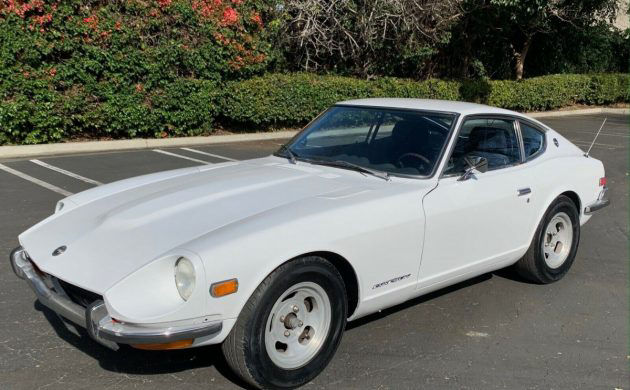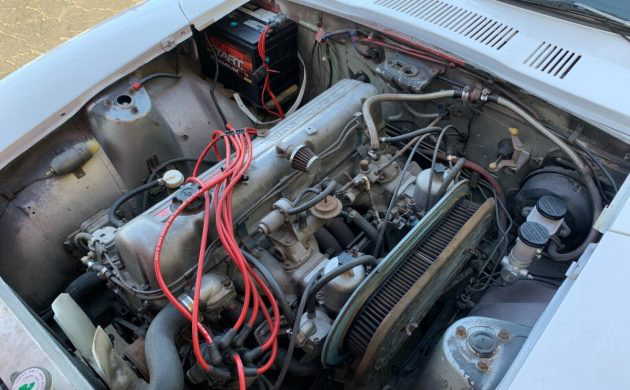While the company never publicly stated it, there’s little doubt that Datsun’s 240Z embodied the spirit of the original Jaguar E-Type. From their hatchback two-seat configuration to their inline six-cylinder engines, it is little wonder that the two cars continue to draw comparisons today. They also share one other important trait, which is that values on both continue to experience strong growth in today’s classic market. The upshot is that when a 240Z appears on the market with No Reserve, it is guaranteed to generate interest. That is the case with this 1972 example that the owner offers for sale here on eBay. Located in Lakewood, California, frantic bidding has already pushed the price to $14,700.
It seems that the seller recently purchased the 240Z from a father-and-son, but he doesn’t indicate why he isn’t retaining the vehicle himself. He states that the car is no trailer queen, although it did undergo a repaint in its original Kilimanjaro White in the early 1990s. The paint still presents well, although it has accumulated a few minor marks and flaws over the past three decades. The panels are straight, but the owner states that there could be some Bondo that he hasn’t discovered. However, the best news with this classic is the absence of rust. It is an issue that can plague these Japanese classics and can impact the spare wheel well, the rear hatch opening, the floors, and the steel under the battery. These areas appear clean, with the floors retaining much of their factory undercoat. The chrome and glass look respectable for a classic of this age, although the wheels would benefit from a spot of attention with a high-quality alloy polish.
This Datsun’s interior is something of a mixed bag and probably won’t appeal to purists seeking complete originality. It appears that the dash may be reconditioned because its existing texture doesn’t match the original appearance. I can’t say that I’m sold on it, but it is a change that the buyer may consider accepting. It is possible to locate a reproduction dash for $800, but they will need to be sitting down when they learn that a reconditioned original dash will lighten their wallet to the tune of $2,500! The previous owners ditched the factory seats and slotted in a set of cloth-upholstered Recaros. However, their condition and the improvements in comfort and lateral support would probably motivate me to retain them, at least in the short term. There is a blanking plate where the radio should be, and a few smaller knobs and controls have gone bye-bye. Rounding out the faults, there is considerable wear on the wheel. If I were to buy this classic, I would probably spend the $800 on a reproduction dash, find a nice stereo to slot into the vacant spot, and bolt on a leather-wrapped Momo wheel. Beyond that, the interior would need very little, with the upholstered surfaces and carpet appearing excellent.
While it may not have been as exotic as the engine found in an original E-Type, the 2,393cc six-cylinder unit located under the hood of this 240Z was not a bad thing. The L-Series Datsun engines are some of the most robust motors produced by a Japanese manufacturer, and they can survive in excellent condition with little maintenance. However, it seems that the numbers-matching unit for this 240Z has been appropriately maintained, meaning it should go close to producing its original 151hp. That power finds its way to the rear wheels via a four-speed manual transmission, allowing the 2,350lb Datsun to skip through the ¼ mile in 16.6 seconds. While that figure doesn’t seem particularly impressive, it only tells part of the story of the 240Z. The company produced these cars with four-wheel independent suspension, which blessed the vehicle with remarkable road-holding and handling when the road turned twisting. It appears that this Datsun is in sound mechanical health, with no significant problems or issues. The owner indicates that the carburetors would benefit from a tune, although if they have never been touched, the buyer may be better served to send them for a rebuild. Otherwise, the 240Z starts, runs and drives extremely well. It seems that it is a turnkey classic awaiting its next owner.
It isn’t unusual to find examples of Datsun’s 240Z for sale today with rust issues awaiting attention. To find one that has spent its life in California and been spared the ravages of tin worm is a bonus. That appears to be the case with our feature car, and it seems that it would take little to lift its presentation to a higher level. When you consider its overall condition and what it offers, it is no surprise to learn that it has already attracted an incredible sixty-three bids. I wouldn’t be surprised to see the action top $20,000 before the hammer falls. So, will you be an interested spectator, or are you tempted to join the bidding frenzy?







I bought a 1971 240Z in 1978. The car had nearly 90k miles then. It was my everyday until I sold it years later for $1500. About evetything mechanical was worn out.
Another one I couldn’t save.
Still one of the nicest Japanese cars ever built.
With over 169,000 240zs built, you gotta wonder where they all went.
Probably most rusted away.
My uncle had a new 280Z? With the turbo, it ran pretty well. The car was less than a year old when the fenders were replaced because they rotted out badly. They were replaced under warranty and he traded it in on something else. The only other new car I saw rit that badly was a year old Volare, they were still bolted on they had a 6″ wide piece of metal from the headlight bezel back, then another 6″ strip over the center of the fender well and then a 8″ piece back to the doors. I love my Mopars and have owned a 340 6pack swapped Volare, but that show how poorly built the 80’s Mopars were.
SOLD for $16,334.